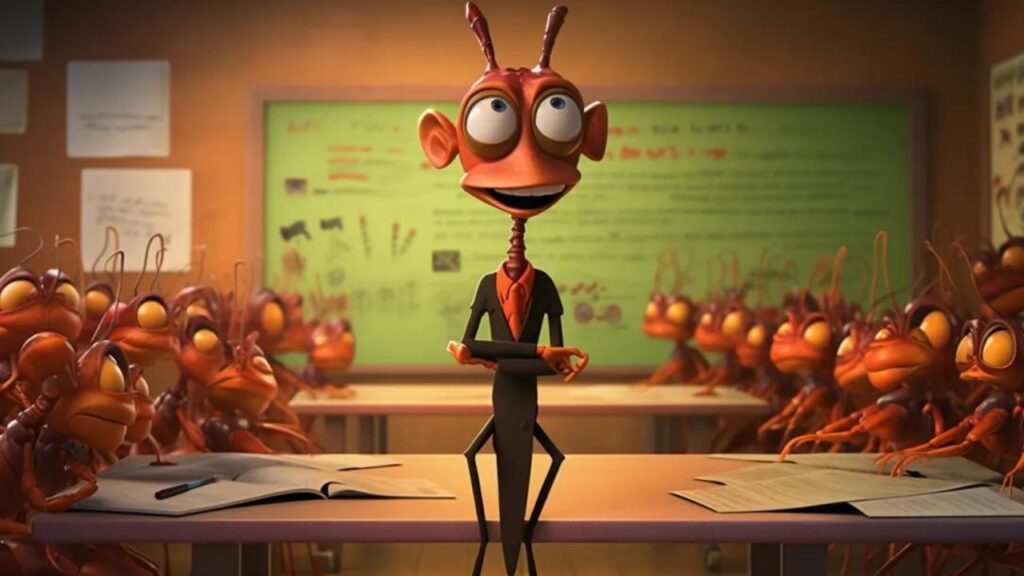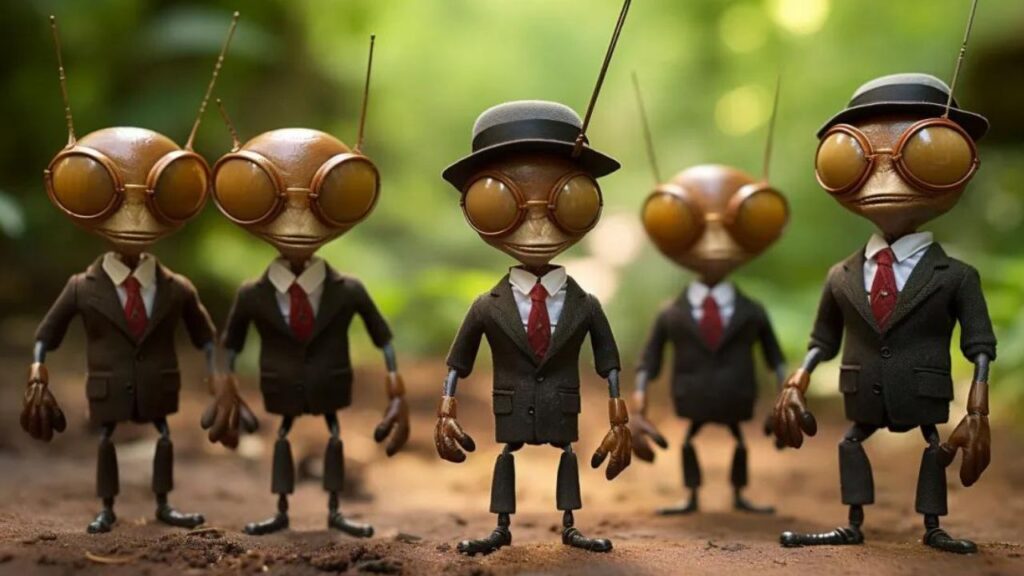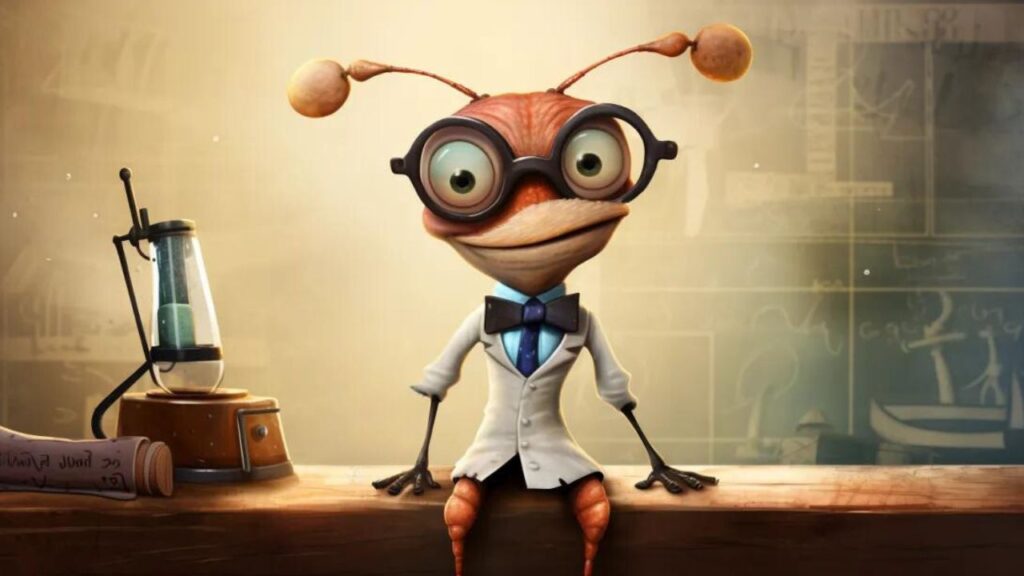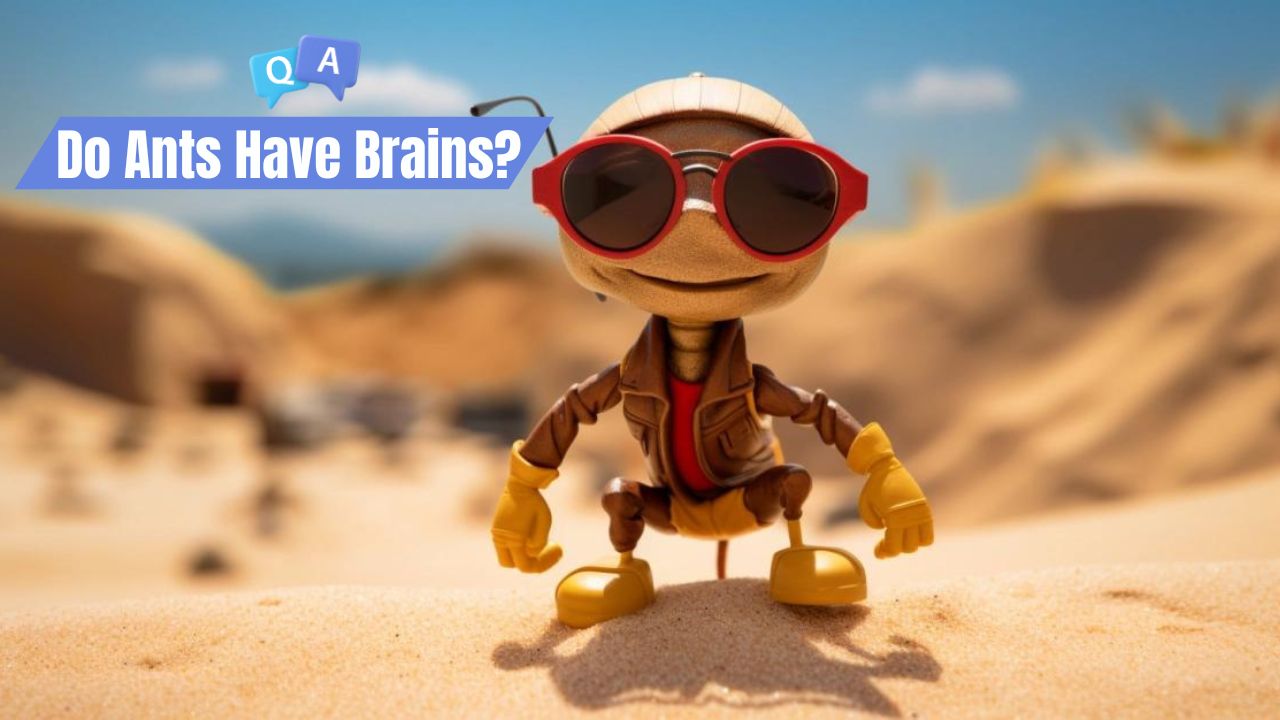TL;DR Summary:
Yes, ants do have brains. Despite their small size, ant brains are proportionately large, dense with neurons, and capable of complex functions. These include learning, memory, navigation, problem-solving, and sophisticated communication through pheromones. Ants’ cognitive abilities play a crucial role in their social structure, division of labor, and adaptation to the environment. The ant brain is not only a marvel of natural engineering but also a source of inspiration for technological innovations in AI and biomimicry. The intricacies of ant neurology provide insights into both the ecological importance of ants and the potential for human advancements.
As Professor Abigail Antenna, I’ve spent countless hours peering into the diminutive yet astonishing world of ants, creatures that have roamed the Earth for millions of years. These insects, often perceived as mere workers and warriors, hold complexities that challenge our understanding of intelligence and social organization. One question that perpetually intrigues enthusiasts and scientists alike is: do ants have brains? This inquiry not only piques our curiosity but also leads us down a path of discovering the remarkable cognitive world of ants.
Ants: A Glimpse into Their World
- A Planet Dominated by Tiny Inhabitants: Ants are among the most successful species on the planet, with thousands of different kinds populating almost every terrestrial environment. Their success is attributed to their social structure and their ability to adapt and communicate, which may hint at a more complex neurological foundation than one would expect from such small beings.
- Architects of the Underworld: The intricate nests and the precise division of labor seen within an ant colony are marvels of natural engineering and organization. Such complexity in behavior and society suggests a level of cognitive processing that begs a deeper look into their neuroanatomy.
- A Spectrum of Behavior: From foraging to farming aphids, ants display a wide spectrum of behaviors that indicate a level of sophistication and problem-solving ability. Understanding how their brains support these complex behaviors is key to appreciating their role in the ecosystem.
The Question of Intelligence in Ants
- Measuring Intelligence in Insects: The concept of intelligence in ants often leads to debate. How do we measure the intelligence of a creature so different from us? In ants, intelligence is not about individual prowess but the collective hive intelligence that emerges from the many interactions within their community.
- The Colony as a Cognitive Unit: In ant colonies, the collective actions resemble a single organism with a shared ‘mind’. The intelligence of ants is, therefore, often considered in terms of the colony’s ability to solve problems and adapt to changes in their environment.
- The Individual’s Contribution: Yet, each ant’s ability to learn, remember, and communicate plays a vital role in the success of the colony. Exploring the individual’s cognitive abilities is essential in understanding the full picture of ant intelligence.
Preview of Ant Neuroanatomy
- A Brain, Defined: Ants do indeed have brains. Despite their minuscule size, ants have a central brain that is quite large in proportion to their body size. This brain is the center of their neural operations, processing sensory input and coordinating the ant’s complex behaviors.
- Complex Circuitry on a Miniature Scale: The ant brain contains a high density of neurons relative to their body size — a feature that supports complex processing and learning capabilities.
- Neuroanatomy and Function: As we preview ant neuroanatomy, we will explore how different parts of the brain are involved in various functions such as olfactory processing, which is vital for communication, and spatial awareness, crucial for navigation.
In the following sections, we’ll delve into the fascinating details of the ant’s nervous system, uncover the depths of their cognitive abilities, and reveal how these tiny creatures with brains not only exist but thrive with a level of intelligence that is crucial for their survival. Join me as we navigate the neural pathways of ants and discover the true extent of their cognitive world.
The Ant’s Nervous System

Ants, with their diminutive size and seemingly robotic behaviors, are easy to overlook as simplistic creatures. Yet, within each ant lies a nervous system that is both complex and capable, rivaling that of much larger organisms. My fascination with myrmecology has led me to study the intricacies of ant neuroanatomy, revealing a world of miniature but mighty neural networks.
Overview of Neural Architecture
- A Compact Nervous System: The nervous system of an ant, like all insects, is a reduced and centralized network of neurons and supporting cells. It consists of a brain located in the head, a ventral nerve cord running through the body, and a series of ganglia that control localized movements and reflexes.
- Neural Efficiency: This compactness lends itself to efficiency. Ants process information and react to their environment quickly, a necessity for their survival. The speed of their decision-making is a direct result of the streamlined architecture of their nervous system.
- Division of Labor: The nervous system is divided into regions that specialize in different tasks, such as processing sensory information, controlling movement, and regulating internal functions. This division of labor within the nervous system mirrors the social structure of the ant colony itself.
The Ant Brain: Structure and Capacity
- Proportionally Large Brains: Despite their small size, ants have proportionally large brains relative to their body mass. In fact, when it comes to the ratio of brain size to body size, ants are among the leaders in the insect world.
- Brain Regions: The ant brain is divided into three primary regions: the protocerebrum, deutocerebrum, and tritocerebrum. Each region has a specific role, with the protocerebrum involved in integration of sensory information and higher order processing, the deutocerebrum primarily handling olfactory signals, and the tritocerebrum connecting to the ant’s mouthparts and further integrating sensory and motor signals.
- Neuronal Density: The brain of an ant is densely packed with neurons, particularly in areas involved in learning, memory, and sensory integration. This high neuronal density is thought to be the key to their complex behaviors and learning capabilities.
Comparing Ant Brains to Other Insects
- Relative to Body Size: When comparing ant brains to those of other insects, it’s important to consider the relative brain-to-body size ratio. Ants have one of the largest brain-to-body size ratios in the insect world, which is indicative of their complex behaviors and social structures.
- Specialized Brain Functions: Ants have developed brain functions that are specialized for their particular needs, such as complex olfactory lobes for chemical communication and spatial learning for navigation. This specialization can be different from other insects, such as bees, which have more developed visual processing areas.
- Learning and Adaptation: The learning and memory capabilities of ants also set them apart from many other insects. Their ability to learn and remember routes, solve problems, and adapt to new situations is a direct result of their advanced neural development.
The nervous system of an ant is a testament to the incredible adaptability and efficiency of these organisms. Their brains, though small, are powerful processors that drive complex behaviors and allow for an advanced level of social organization. In studying the neural architecture of ants, we gain insights into how a high density of neurons and specialized brain regions contribute to the extraordinary capabilities of these ubiquitous creatures.
Do Ants Have Brains?

In the bustling microcosm of an ant colony, it’s easy to mistake these creatures for automatons, driven solely by instinct. However, as a myrmecologist, I can assure you that ants are much more than biological robots. A common question I encounter is whether these insects, known for their industrious nature, actually have brains. The answer is a definitive yes, and the functions of their brains are as fascinating as the ants are industrious.
Defining the Brain in Ants
- A Concentrated Mass of Nerve Cells: The ant brain is a concentrated mass of nerve cells (neurons) located within the head. Though minuscule, it is a true brain by all scientific definitions. It processes sensory information, regulates the ant’s bodily functions, and coordinates its movements and behaviors.
- The Central Processing Unit: Just like in humans, the ant’s brain acts as the central processing unit, controlling the nervous system. It receives signals from the ant’s sensory organs and issues commands to the rest of the body, enabling the ant to respond appropriately to its environment.
- The Seat of Learning and Memory: The brain is also the seat of learning and memory in ants. Contrary to the assumption that ants are purely instinctual, they possess the ability to learn from experience and modify their behavior accordingly, which is a clear sign of cognitive processing.
The Role of the Brain in Ant Behavior
- Behavioral Control: The ant brain controls a range of complex behaviors, from navigating back to the nest from great distances to distinguishing between friend and foe. These tasks require both innate programming and the ability to learn and adapt, all of which are governed by the brain.
- Social Interaction and Communication: One of the most remarkable aspects of ant behavior is their social interaction. The brain enables ants to communicate with their colony members through chemical signals and to fulfill their roles within the highly structured social hierarchy of the colony.
- Decision-Making Abilities: Ants make decisions constantly, whether it’s choosing a food source, finding a mate, or defending the nest. These decisions are not random; they are made based on information processed in the brain, weighing various factors and choosing the best course of action.
Neurological Adaptations for Survival
- Evolutionary Refinements: The ant brain has undergone evolutionary refinements to support survival in a range of environments. From the desert-dwelling ant species that can navigate by the position of the stars, to the leafcutter ants that engage in complex farming practices, their brains are adapted to meet specific ecological challenges.
- Efficient Use of Resources: Ants have also evolved to use their neural resources efficiently. Their brains are capable of complex tasks without the need for size; instead, they use a high density of neural connections and efficient pathways to process information.
- Resilience and Flexibility: The ant brain exhibits a remarkable resilience and flexibility. Ants can re-learn tasks if conditions change, indicating a level of neural plasticity. This adaptability is crucial for a species that lives in environments that can be both dynamic and unpredictable.
In conclusion, ants do have brains, and the capabilities of these brains are as complex as they are impressive. The ant brain orchestrates a suite of behaviors that are sophisticated, flexible, and highly adapted to the challenges of survival in the insect world. Far from being the simple creatures many assume them to be, ants are a testament to the power of evolution to create miniature masterpieces of neural engineering.
Cognitive Abilities of Ants

Throughout my academic career as a myrmecologist, the cognitive world of ants has captivated me deeply. Their minute brains belie a cognitive prowess that rivals larger and more ‘advanced’ organisms. The intelligence of ants is manifested in various abilities, including learning, memory, problem-solving, and communication — all of which are pivotal for their survival in the ever-changing tapestry of their ecological niches.
Learning and Memory
- Remarkable Learning Capabilities: Ants demonstrate the ability to learn from their experiences, a hallmark of cognitive complexity. They can navigate to and from their nest using visual landmarks, remembering and interpreting these cues over time.
- Spatial Learning: One of the most striking displays of ant intelligence is their spatial learning. They use a process called ‘path integration’, where they keep track of the distance and direction traveled to find the most direct route back to their nest.
- Associative Learning: Ants are also capable of associative learning. They can associate specific smells with food sources or learn to avoid certain paths that pose a danger. This capability indicates that ants can modify their behavior based on past outcomes, a sign of true learning.
Problem-Solving Skills
- Obstacle Navigation: Ants are frequently seen navigating complex obstacles. When faced with a barrier, they assess and employ various strategies to overcome it. This could mean finding an alternate path, digging through, or even building a bridge with their bodies.
- Adaptive Foraging Strategies: Ants also exhibit problem-solving in their foraging strategies. When a food source becomes too difficult to exploit, ants will switch to a more accessible one, demonstrating an ability to weigh costs and benefits.
- Collective Problem-Solving: Perhaps most impressive is the ants’ collective problem-solving ability. When a single ant cannot overcome a challenge, the colony acts as a superorganism, combining the cognitive abilities of individual ants to solve complex problems.
Communication and Pheromone Signaling
- Chemical Language: Ants communicate primarily through chemicals called pheromones. This chemical language is incredibly nuanced, allowing ants to send specific messages, signal alarms, leave trails to food sources, and even indicate their status within the social hierarchy.
- Sophisticated Messaging System: The complexity of ant communication can be seen in how they use pheromones to organize their labor, from foraging to defending the nest. The brain interprets these chemical signals and prompts a coordinated response from the colony.
- Inter-Ant Dialogue: Beyond pheromones, ants use their antennae and body movements to ‘talk’ to each other, conveying information about food, navigation, or even recruiting other ants for tasks. This inter-ant dialogue is a testament to their advanced social intelligence and cognitive abilities.
The cognitive abilities of ants are a window into the intricate workings of evolution. Learning, memory, problem-solving, and communication are not just traits of higher animals but are present in these tiny insects, enabling them to thrive in almost every terrestrial habitat on Earth. Their diminutive brains are hubs of high cognitive function, proving that when it comes to intelligence, size isn’t everything. Through my studies, I’ve learned that each ant is a node in a vast neural network that constitutes the colony, with every individual’s brain contributing to the collective intelligence of the group. This collective cognitive power is what makes the ant colony one of the most successful social systems in the animal kingdom.
The Brain and Ant Social Structure

In the realm of ants, social structure is not a mere byproduct of communal living but a sophisticated system that hinges on the cognitive abilities of individual members. My research has illuminated how the brains of ants are integral to this structure, enabling a division of labor that is both complex and efficient. Let’s delve into the relationship between the ant brain and their societal organization.
Division of Labor and Brain Function
- Specialized Roles: In an ant colony, each member has a role, from foragers and caregivers to soldiers and the queen. The brain of each ant is wired to excel in specific tasks, a phenomenon that is as much neurological as it is behavioral.
- Neurological Underpinnings: The brain structure of ants varies depending on their roles. For instance, foragers may have well-developed areas for spatial memory, while ants tasked with brood care may have enhanced olfactory regions to better recognize the needs of the young.
- Behavioral Plasticity: The ant brain is also capable of plasticity, meaning that ants can switch roles if the needs of the colony demand it. This flexibility is a sign of the brain’s adaptability and is crucial for the resilience of the colony.
Navigation and Foraging
- Sophisticated Navigation: Ants are famed navigators, often traveling great distances and returning to their nest without fail. Their brains process complex information from their surroundings, using visual cues and the sun’s position as a compass.
- Foraging Strategies: The brain is also the command center for their foraging strategies. Ants can recall the location of food sources and the best paths to reach them. They also use their brains to evaluate the quality of food and communicate this information to nestmates.
- Pheromone Mapping: Pheromone trails, which ants use to mark paths to resources, are interpreted by the brain. This chemical mapping is an ingenious navigation aid that exemplifies the brain’s role in foraging behaviors.
Reproduction and the Role of the Queen
- The Queen’s Brain: The queen ant’s brain is specialized for reproduction. While her primary role is to lay eggs, she also produces pheromones that influence the behavior and development of the entire colony, an ability that stems from her unique neural makeup.
- Reproductive Decisions: The queen’s brain allows her to make crucial reproductive decisions, such as when to mate and where to establish a new colony. Her brain governs the timing and production of pheromones that will suppress or encourage the development of new queens and males.
- Influence on Colony Genetics: Beyond her immediate biological functions, the queen’s brain has a long-term impact on the genetics of the colony. Her mating choices and the success of her offspring are central to the genetic diversity and adaptability of future generations.
The brain of an ant is not just a center for individual cognition but a cornerstone of the entire colony’s social structure. It orchestrates the division of labor, underpins complex navigation and foraging behaviors, and ensures the continuation of the colony through the queen’s reproductive decisions. In my explorations, I have come to appreciate the ant brain as a masterful conductor of life’s symphony, guiding each ant in its role, ensuring the harmony and survival of its society. The social structure of ants, with its division of labor, collaborative problem-solving, and unified reproductive goals, is a direct reflection of the cognitive capabilities and neural specializations of these remarkable creatures.
Brain Development in Ants

In the study of ant development, the brain is of particular interest. From larva to adult, the transformation of the ant’s brain is a journey that fascinates myrmecologists and neuroscientists alike. This growth is not merely physical but encompasses the expansion of cognitive capabilities essential for the ant’s survival and integration into the colony’s complex social structure.
From Larva to Adult: Brain Growth
- Stages of Development: The ant’s life begins as an egg, progressing to the larval stage, then to pupation, and finally to adulthood. Throughout these stages, the brain undergoes significant changes in both size and structure to meet the evolving demands of each stage.
- Neural Expansion: As larvae, ants have rudimentary brain structures, sufficient for basic functions such as feeding. During the pupal stage, there is a marked increase in brain size and neuron count, preparing the ant for its adult duties. This growth is particularly pronounced in the mushroom bodies, areas of the brain associated with sensory processing and learning.
- Maturation and Specialization: By the time ants reach adulthood, their brains have matured to reflect their specialized roles within the colony. The brain’s development is fine-tuned according to the tasks the ant will perform, whether it be foraging, nest maintenance, or caring for the young.
The Impact of Environment on Brain Size
- Environmental Influences: The environment plays a critical role in the development of the ant’s brain. Nutrition, social interactions, and the physical demands of the ant’s habitat all influence brain growth and development.
- Nutritional Factors: Adequate nutrition is essential for optimal brain development. Larvae destined to become queens or major workers, who require larger brains for their complex tasks, are often fed more or higher quality food.
- Learning and Brain Growth: Ants exposed to enriched environments that require complex navigation, problem-solving, or learning show increased brain growth. This suggests that the brain’s development is directly affected by the cognitive demands placed on the ant.
Seasonal Changes and Brain Plasticity
- Adaptation to Seasons: Ants display remarkable brain plasticity in response to seasonal changes. Some species of ants have been shown to experience an increase in brain size during seasons that demand more cognitive abilities, such as when foraging or colony expansion is most active.
- Plasticity and Survival: This plasticity is a survival mechanism. As the seasons change, so do the roles and responsibilities of the ants. Their brains adapt to these changes, shrinking or growing as necessary to conserve energy or enhance cognitive function.
- A Dynamic Organ: The ant brain is not static but is a dynamic organ, changing throughout the individual’s life to adapt to the internal and external demands of colony life.
In summary, the development of the ant’s brain from larva to adult is a finely tuned process influenced by genetics, environment, and social needs. The remarkable plasticity of the ant’s brain, its ability to change in response to environmental and seasonal variables, underscores the adaptive capabilities of these insects. My investigations into the neurodevelopment of ants reveal an organ that is as dynamic as the environments the ants inhabit, ensuring that they remain one of the most successful and resilient species on the planet.
Ant Brains and Human Science

The diminutive ant brain, often overlooked in its complexity, holds valuable lessons for human science. My own fascination with ant neurology has led me to draw parallels between their cognitive processes and our technological endeavors in artificial intelligence, as well as to seek inspiration for biomimicry in design. The study of ants is not just about understanding another species; it’s about harnessing their ancient wisdom to propel human innovation.
What Ant Brains Teach Us About AI
- Decentralized Intelligence: The decentralized decision-making process in ant colonies, where no single ant is in charge, is akin to the principles we strive to replicate in artificial intelligence systems. This self-organized system provides insights into how simple rules at the individual level can lead to complex behavior in a collective.
- Efficiency in Processing: Ants can process vast amounts of information and make decisions with speed and accuracy, a trait we aim to instill in AI. Understanding how ant brains achieve this with minimal energy and neural hardware can inform the development of more efficient computational algorithms.
- Adaptability and Learning: The ability of ants to adapt and learn is something AI strives to emulate. By studying how ant brains rewire and adapt to new situations, we can improve machine learning techniques, allowing AI systems to better adjust to changing environments.
Biomimicry: Learning from Ant Neurology
- Design Inspired by Nature: Biomimicry is the art of designing systems that imitate natural processes. The ant brain, optimized by millions of years of evolution, offers a blueprint for creating more robust and adaptable systems.
- Sensory Integration: The way ant brains integrate multiple sensory inputs into a cohesive picture is inspiring designs for multisensory technology in robots and autonomous vehicles. By mimicking the sensory fusion of ant brains, these systems can navigate and understand complex environments more effectively.
- Collective Robotics: The field of swarm robotics draws heavily from ant colonies. By studying how ants communicate and coordinate, engineers can program robots to work together in swarm-like behavior to perform tasks too challenging for individual robots.
Future Research Directions in Myrmecology
- Neurological Research: As we continue to explore the ant brain, there is potential for new discoveries in neuroscience. Ants could hold the key to unlocking mysteries about neural development, brain plasticity, and memory formation.
- Understanding Societal Impact: Research into how ant brains contribute to colony behavior can also offer deeper insights into the societal impacts of individual cognitive function. This can have broader implications for understanding the health and sustainability of human societies.
- Ecosystem and Biodiversity Studies: Ants play a crucial role in many ecosystems. Studying their brains and behaviors can help us understand how to preserve biodiversity and maintain the ecological balance.
In conclusion, the study of ant brains extends beyond mere academic curiosity. It is a venture that intersects with artificial intelligence, biomimicry, and ecological conservation. As a myrmecologist, I find that each discovery about ant neurology not only reveals more about these incredible insects but also reflects back upon our understanding of intelligence, both artificial and organic. The potential applications of these discoveries are as vast as the colonies of ants themselves, promising exciting advancements in technology and deepening our respect for the natural world.
Conclusion

As we come to the end of this enthralling exploration into the cognitive world of ants, it’s clear that these tiny creatures are not just instinct-driven automatons but rather possess a sophisticated neurological foundation. The ant brain, though small, is mighty, and it’s been my pleasure to share the intricate details of its workings.
Recap of Ant Cognitive Abilities
- Learning and Adaptation: Ants exhibit remarkable learning abilities, from navigating complex terrains to altering foraging strategies in response to environmental changes. These skills are underpinned by a brain capable of impressive memory and spatial awareness.
- Problem-Solving and Communication: Their problem-solving skills, both individually and collectively, demonstrate a level of intelligence that is essential for the success of their colonies. Coupled with intricate methods of communication, mainly through pheromone signaling, ants coordinate their efforts with precision and efficiency.
- Role in the Social Structure: The ant brain is not only central to individual survival but is also a cornerstone of the colony’s social structure. It governs a sophisticated division of labor, ensures effective navigation and foraging, and oversees the complex reproductive processes that perpetuate the colony.
The Significance of the Ant Brain in Ecology
- Ecosystem Engineers: In ecology, ants are known as ecosystem engineers. Their activities significantly affect the soil structure, plant pollination, and the distribution of seeds. The ant brain orchestrates these activities, which in turn have profound effects on ecosystem health and biodiversity.
- Biological Indicators: Furthermore, the behavior of ants, directed by their neurological processes, can serve as an indicator of ecological changes. Shifts in ant behavior often signal alterations in the environment, making them valuable biological indicators in conservation and management efforts.
Final Thoughts on the Ingenuity of Ants
- A Model of Efficiency: The ant brain is a model of efficiency, managing complex tasks with minimal energy consumption. This efficiency is something that, as humans, we strive to achieve in our own technological advancements.
- Inspiration for Innovation: The ingenuity of ants, from their brain function to their societal organization, continues to inspire innovation. In robotics, computing, and even social theory, ants provide a blueprint for creating systems that are both resilient and adaptable.
- Reflecting on Our World: Studying ants prompts us to reflect on our place in the world. It highlights the interconnectedness of all life forms and the importance of respecting and learning from even the smallest members of our global ecosystem.
In summary, the study of ant cognitive abilities and their brains has far-reaching implications, from advancing artificial intelligence to enhancing our understanding of ecological systems. Ants teach us that complexity does not necessarily equate to size and that there is immense sophistication in the miniature. Their ingenuity is a powerful reminder of nature’s brilliance, inviting us to continue exploring, learning, and marveling at the world beneath our feet. As I continue my research in myrmecology, I am constantly reminded that within the tiny brain of an ant lies a vast and largely untapped reservoir of knowledge, waiting to enlighten us with the secrets of life’s incredible intricacy.

